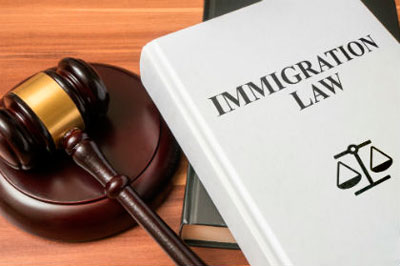All American business owners are affected in some way by immigration law, whether it’s securing H-1B visas for high-tech employees or checking I-9 forms for migrant farm workers. This section provides resources for employers regarding employment eligibility verification, foreign worker visa programs, and other immigration laws.
Employment Eligibility Verification
The federal government has always required employers to verify the eligibility of their employees to work in the United States. The Department of Homeland Security (DHS) instituted new requirements regarding how this must be accomplished and began to strictly enforce verification of employment eligibility in recent years. Consequently, employers must now be especially diligent in meeting their reporting obligations.
 Employers must complete I-9 eligibility forms within three days of hiring an employee. The employee provides his name, date of birth, address and Social Security number, which is compared to national databases. Under the new regulations, employers can now electronically store I-9 forms, verify employment eligibility online, and know what to do if the employee’s information does not match the information provided by the government.
Employers must complete I-9 eligibility forms within three days of hiring an employee. The employee provides his name, date of birth, address and Social Security number, which is compared to national databases. Under the new regulations, employers can now electronically store I-9 forms, verify employment eligibility online, and know what to do if the employee’s information does not match the information provided by the government.
Although most issues are resolved within a week after filing an I-9 form online, though in some cases the employee will need to submit additional information such as photographs and other documents to help establish identity or employment authorization. If verification is impossible, the employee must be fired.
Obtain a foreign labor certificate
Employers who want to sponsor an employee for a green card generally must first apply for a foreign labor certificate on their behalf. Sponsoring employees for residency can be time-consuming and procedurally complicated. Employers must establish that there is a shortage of qualified employees for the position they are seeking to fill before applying for residency for their worker.
The process for establishing a worker shortage is referred to as a PERM labor certification, or simply a labor certification. This process involves the employer advertising and interviewing eligible candidates for a position and demonstrating their inability to fill the position within a reasonable time before hiring the foreigner. Certain types of employment-based or job-specific green cards are exempt from meeting labor certification requirements. Workers with extraordinary abilities, those with advanced degrees, and other wealthy or well-skilled immigrants may be eligible to circumvent labor certification requirements.
E-Verify
DHS, in association with the Social Security Administration (SSA), maintains a database of valid Social Security numbers and the names of the people associated with them. Employers can now use this system to electronically verify the employment eligibility of potential employees and, in some cases, are required to do so. Federal contractors and companies that contract with some state governments are required to use electronic verification. State legislatures have increasingly passed laws requiring public and even private employers to use electronic verification for all newly hired employees. If the information entered does not match the information in the DHS / SSA database, the result is an “unsatisfactory nonconfirmation” (TNC) and both the employee and the employer need to take action to resolve the issue.
E-Verify Basics
It is the employer’s responsibility to verify the eligibility of a newly hired employee to legally work in the United States. To be eligible, you must be a US citizen, lawful permanent resident (LPR), or in-country with a valid visa. To verify the eligibility of a newly hired employee, you must verify at least two forms of identification, including a Social Security card, as required on Form I-9 (see “Employment Eligibility Verification”). Additionally, the federal government’s E-Verify database provides employers with a more convenient way to verify employee eligibility.
Here is an overview of the E-Verify system, which is required of some employers but optional for others. See the Immigration Law for Employers section for more information.
E-Verify: Summary
The Department of Homeland Security (DHS), in partnership with the Social Security Administration (SSA), maintains a central database of valid Social Security numbers and the names of the people associated with each of them. Called “E-Verfiy,” the system allows participating employers to electronically verify the employment eligibility of a newly hired worker in seconds.
E-Verify also has a photo matching feature, which occurs automatically for employees who have presented a passport, permanent resident card (“green card”), or an employment authorization document (form I-766).
Employers using E-Verify must complete and submit an I-9 form for each new employee.
When is E-Verify a requirement?
Certain federal contractors and companies that contract with some state governments must verify employment eligibility through E-Verify. For more details on Contractor Requirements, see «Supplemental E-Verify Guide for Federal Contractors«.
Additionally, a growing number of state legislatures have passed laws requiring public and / or private employers to use E-Verify for all newly hired employees. See “State Immigration Laws” for state-by-state information on E-Verify requirements.
How E-Verify works
Employers who choose (or are required to) use E-Verify must first register with DHS. During the online enrollment process, you will be asked a series of yes / no questions and given information about your company. See page «The Enrollment Process»From the agency for more details and a link to the enrollment website.
Once enrolled, employers can simply log into the E-Verify system using an assigned user ID and password to get started. New users will be asked to take a tutorial before using the system to verify the Social Security numbers of new hires.
What to do if E-Verify cannot confirm a match
If the information provided by the employee matches what appears in the E-Verify database, the employer receives an “Authorized Employment” response. In some cases, E-Verify returns a “DHS Verification in Process” response, which means that a manual review is required.
But if the information does not match, a so-called “provisional nonconfirmation” (TNC) is returned, prompting the employee and employer to take steps to resolve the issue. There are some legitimate reasons for a mismatch, including inaccurate government records, so DHS or SSA will contact the employee for more information.
Do you need legal help with the verification process?
While you do not need an attorney to conduct eligibility checks for potential new hires, you may find yourself in certain situations that require specific legal knowledge. For example, there could be a false positive that needs to be cleared up with DHS or you could be on the receiving end of an employee’s legal action. In such cases, you are advised to contact a business and commercial law attorney or immigration attorney well versed in business law.

